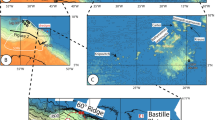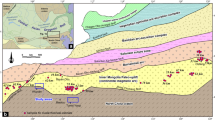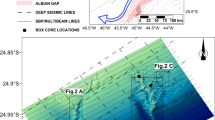Abstract
CORES of a lower Tertiary lateritic palaeosol resting on basalt were recovered1 from Deep Sea Drilling Project Site 336 (Leg 38) on the north-east flank of the Iceland–Faeroe Ridge (Fig. 1), a major aseismic oceanic ridge that, together with Iceland, forms the Icelandic transverse ridge2. The transverse ridge extends from the West European continental margin to the East Greenland continental margin, forming the geographic boundary and a partial barrier to flow of water between the Norwegian–Greenland Sea to the north and the northern North Atlantic Ocean to the south. The palaeosol indicates that at least part of the Iceland–Faeroe Ridge was above sea level during early Tertiary time3. Palaeogeographic and palaeooceanographic reconstructions suggest that it formed the main part of the Thulean land bridge that connected South-east Greenland and the Faeroe islands during the early Tertiary4. This report summarises the subsidence history of the Iceland–Faeroe Ridge relative to early Tertiary seafloor spreading, basaltic volcanism, and the development of the proposed Thulean land bridge.
This is a preview of subscription content, access via your institution
Access options
Subscribe to this journal
Receive 51 print issues and online access
$199.00 per year
only $3.90 per issue
Buy this article
- Purchase on Springer Link
- Instant access to full article PDF
Prices may be subject to local taxes which are calculated during checkout
Similar content being viewed by others
References
Talwani, M. et al. Init. Rep. DSDP 38 (US Govt Printing Office, Washington, 1976).
Bott, M. H. P. in Geodynamics of Iceland and the North Atlantic area, 33–47 (Reidel, Dordrecht, 1974).
Nilsen, T. H. & Kerr, D. R. Init. Rep. DSDP 38, Suppl. (in the press).
Nilsen, T. H. & Kerr, D. R. Geol. Mag. 115 (in the press).
Pitman, W. C., III & Talwani, M. Bull. Geol. Soc. Am. 83, 619–646 (1972).
Talwani, M. & Eldholm, O. Bull. Geol. Soc. Am. 88, 969–999 (1977).
Vogt, P. R. Earth planet. Sci. Lett. 13, 153–160 (1971).
Laughton, A. S. Norg. Geol. Unders. 316, 169–193 (1975).
Keen, M. J., Johnson, J. & Park, I. Can. J. Earth Sci. 9, 689–708 (1972).
Kristofferson, Y. & Talwani, M. Bull. Geol. Soc. Am. 88, 1037–1049 (1977).
Vogt, P. R. & Avery, O. E. in Marine Geology and Oceanography of the Arctic Seas 83–117 (Springer, New York, 1974).
Kharin, G. H. et al. Init. Rep. DSDP 38, 755–759 (1976).
Rasmussen, J. & Noe-Nygaard, A. Danm. Geol. Unders. 25 (1970).
Evans, A. L., Fitch, F. J. & Miller, J. A. J. geol. Soc. 129, 419–443 (1973).
Purdy, J. W., Mussett, A. E., Charlton, S. R., Sackford, M. J. & English, H. N. Geophys. J. R. astr. Soc. 27, 327–335 (1972).
Roberts, D. G. Nature 223, 819–820 (1969).
Beckinsdale, R. D., Brooks, C. K. & Rex, D. C. Bull. geol. Soc. Denmark 20, 27–37 (1970).
Clarke, D. B. & Pederson, A. K. in Geology of Greenland 364–385 (Greenland Geological Survey, 1976).
Clarke, D. B. & Upton, B. G. J. Can. J. Earth Sci. 8, 248–258 (1971).
Schilling, J.-G. & Noe-Nygaard, A. Earth planet. Sci. Lett. 24, 1–14 (1974).
Schilling, J.-G. Nature 242, 565–571 (1973).
Schilling, J.-G. Init. Rep. DSDP 38, 741–750 (1976).
Lindroth, C. H. The Faunal Connections Between Europe and North America (Wiley, New York, 1957).
McKenna, M. C. Proc. 24th Int. Geol. Cong. 7 (Paleontologie) 275–281 (1972).
Moorbath, S., Sigurdsson, H. & Goodwin, R. Earth planet. Sci. Lett. 4, 197–205 (1968).
Johnson, G. L. & Tanner, B. Jökull 21, 45–52 (1971).
Jones, E. J. W., Ewing, M., Ewing, J. T. & Eittrem, S. L. J. geophys. Res. 75, 1655–1680 (1970).
Sclater, J. G., Anderson, R. N. & Bell, M. L. J. geophys. Res. 76, 7888–7915 (1971).
Parson, B. & Sclater, J. G. J. geophys. Res. 82, 803–827 (1977).
Detrick, R. S., Sclater, J. G. & Thiede, J. Earth planet. Sci. Lett. 34, 185–196 (1977).
Sclater, J. G., Hellinger, S. & Tapscott, C. J. Geol. 85, 509–552 (1977).
Roberts, D. G. Phil. Trans. R. Soc. A 278, 447–509 (1975).
Vogt, P. R. Nature 239, 79–81 (1972).
Nilsen, T. H. in Crustal Evolution in North-west Britain and Adjacent Regions (Geol. J. Spec. Issue 10, in the press).
Author information
Authors and Affiliations
Rights and permissions
About this article
Cite this article
NILSEN, T. Lower Tertiary laterite on the Iceland–Faeroe Ridge and the Thulean land bridge. Nature 274, 786–788 (1978). https://doi.org/10.1038/274786a0
Received:
Accepted:
Issue Date:
DOI: https://doi.org/10.1038/274786a0
This article is cited by
-
Verteilung und Herkunft der Sedimente in Lotkernen von der Island-Färöer-Schwelle (Nordatlantik)
Geologische Rundschau (1983)
Comments
By submitting a comment you agree to abide by our Terms and Community Guidelines. If you find something abusive or that does not comply with our terms or guidelines please flag it as inappropriate.



